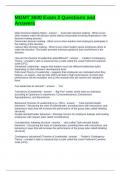Exam (elaborations)
MGMT 3600 Exam 2 Questions and Answers
- Course
- Institution
MGMT 3600 Exam 2 Questions and Answers Major Decision-Making Styles Autocratic decision-making - What occurs when leaders make the decision alone without necessarily involving employees in the decision-making process. Democratic decision making - What occurs when leaders and employees participat...
[Show more]



